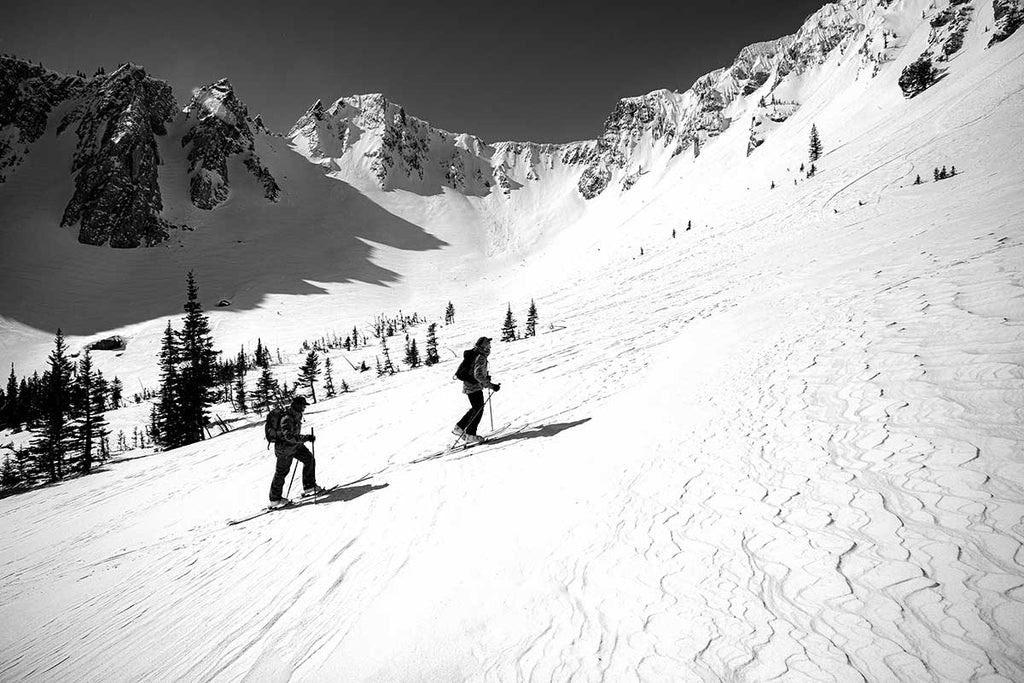The WNDR Guide to Bindings
 When there’s a lot of vertical to earn, the right setup can make or break your tour. Bridger Range. FOWs: Tyler Miller and Matt Sterbenz // Photo: Carson Meyer (@carsonmeyerphoto)
When there’s a lot of vertical to earn, the right setup can make or break your tour. Bridger Range. FOWs: Tyler Miller and Matt Sterbenz // Photo: Carson Meyer (@carsonmeyerphoto)
We want the experience of ordering our skis to be just like riding the skis themselves - smooth and effortless. For this reason, we offer a variety of bindings on our webstore, and will happily drill and mount them to your specified boot sole length for free before shipping. Or, for those who already have their dream bindings on hand, we also offer the option to order your skis flat.
But which bindings are the most appropriate for your own inclinations is another matter. As manufacturers continue to make better, more advanced, and often more specialized gear, the discussion of what binding is perfect for you gets more nuanced. The conversation becomes less about what binding is better, and more about what binding is right for a particular type of skier.
With that in mind, the following is a guide to the bindings that we like to pair with our skis and the types of skiing that each binding is best suited to.
Traditional Tech Setup
When skiers refer to a tech binding, they’re most often talking about this style of binding. The Marker Alpinist is an ultralight, 245g binding that facilitates rapid ascents and efficient skinning. The name of the game here is minimalism, but the Alpinist still packs in the most important features - namely 5 and 9 degree heel risers and an adjustable lateral release function.
If you prioritize efficiency and intend to spend 100 percent of your time in the backcountry, this is the binding for you. Long approaches and tall peaks are more than likely to be on your itinerary, and you’re happy with a very minimal binding if it means you can cover more ground.
Hybrid Pin Binding
 The Marker Kingpin 13. For long tours and big mountain objectives.
The Marker Kingpin 13. For long tours and big mountain objectives.The Kingpin features a combination of attributes that make it the perfect tool for many backcountry skiers. The binding’s tech toe pieces make touring a breeze, and 7 and 13 degree heel risers offer ample assistance on steep skin tracks. But what truly sets the Kingpin apart is its burly, alpine-style heel piece, which provides an extremely planted, “locked-in” feel relative to a traditional tech heel. This translates to more control and predictability on any descent, which makes it a dependable choice for both hard chargers and anyone seeking more confidence from their touring skis.
And while this isn’t the perfect binding for resort use, the addition of brakes and a DIN/ISO certified release function means you can get away with it for the occasional inbounds lap when conditions aren’t optimal in the backcountry.
For many in the aggressive descending touring crowd, Kingpins are a mainstay. If you earn your turns, but prioritize descending confidence, these are the bindings for you.
Freeride Bindings
Compatible with standard resort and touring soles, the Griffon will play nicely with the rest of your quiver, and Marker’s Power Width Design allows excellent power transfer when paired with a wider ski like the Intention 110. This is a binding for skiers that want to descend aggressively with perfect control and maximum safety.
Lighter or less aggressive skiers may also favor the Marker Squire, which offers Griffon-like performance, but in a less burly package with a lower maximum DIN value and price point.
All of the bindings listed above are available to be custom mounted to your own boot sole length before we ship your skis. Don’t hesitate to get on your dream setup!
Looking for a more complete package? Check out our kits, which include deals on essential backcountry accessories beyond skis and bindings.
Disclaimer: No matter what bindings you choose, always have them adjusted by a trained professional before skiing!





